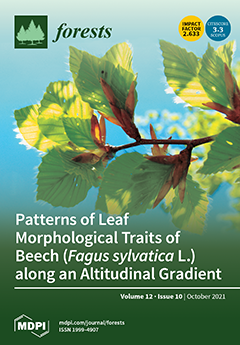Effective initiatives for forest-based mitigation of climate change rely on continuous efforts to improve the estimation of forest biomass. Allometric biomass models, which are nonlinear models that predict aboveground biomass (
AGB) as a function of diameter at breast height (
D) and tree height (
H), are typically used in forest biomass estimations. A combined variable
D2H may be used instead of two separate predictors. The Q-ratio (i.e., the ratio between the parameter estimates of
D and parameter estimates of
H, in a separate variable model) was proposed recently as a measure to guide the decision on whether
D and
H can be safely combined into
D2H, being shown that the two model forms are similar when
Q = 2.0. Here, using five European beech (
Fagus sylvatica L.) biomass datasets (of different Q-ratios ranging from 1.50 to 5.05) and an inventory dataset for the same species, we investigated the effects of combining the variables in allometric models on biomass estimation over large forest areas. The results showed that using a combined variable model instead of a separate variable model to predict biomass of European beech trees resulted in overestimation of mean
AGB per hectare for
Q > 2.0 (i.e., by 6.3% for
Q = 5.05), underestimation for
Q < 2.0 (i.e., by –3.9% for
Q = 1.50), whereas for
Q = 2.03, the differences were minimum (0.1%). The standard errors of mean
AGB per hectare were similar for
Q = 2.03 (differences up to 0.2%), and the differences increased with the Q-ratio, by up to 10.2% for
Q = 5.05. Therefore, we demonstrated for European beech that combining the variables in allometric biomass models when
Q ≠ 2.0 resulted in biased estimates of mean
AGB per hectare and of uncertainty.
Full article





